
Bulletin 1 (I:1) May 1963
Home
Français
Introduction
History
Annual Index
Author & Subject
Credits
Contact

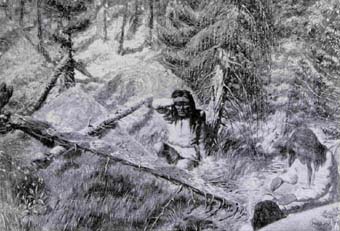
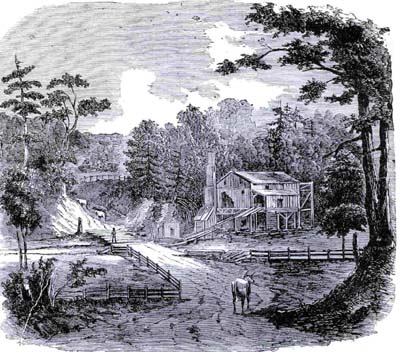
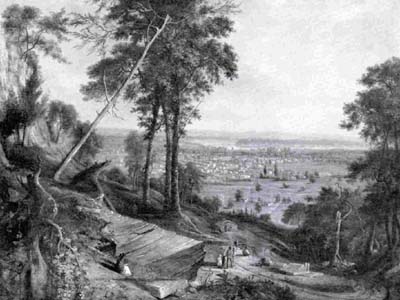
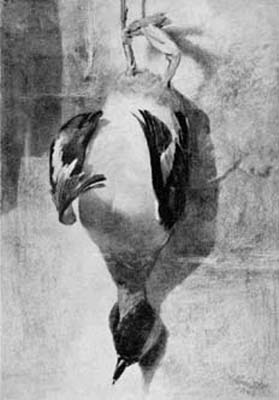
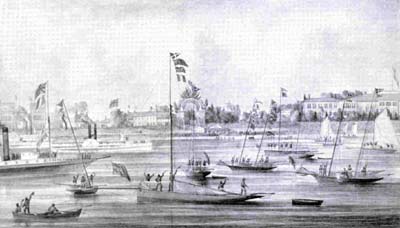
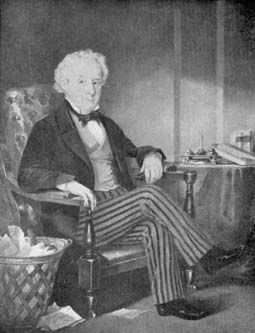
A Study of Art at the Upper Canada
Provincial Exhibitions
Ontario Painters 1846-1867
by J. Russell Harper, Curator of Canadian Art
Pages 1
| 2
| 3
| 4
| 5
| 6 | 7
The agricultural prize lists throw new light on personalities already well-known to those interested in the 19th century Canadian art scene. Paul Kane's name dominated the oil painting awards for several years. He exhibited between 1850 and 1857, and his absence one year was mentioned as lessening the exhibition's general quality. Kane was such a celebrated figure that his attendance was noted at Brockville in 1851. The exhibition review makes extensive reference to him and gives ample evidence of the high regard in which he was held by his contemporaries. It reads:
We would make particular mention of the beautiful and spirited oil paintings by Paul Kane representing the Indians and scenery of the far West: no. 1 shows the mode of travelling in these distant regions in sleighs drawn by dogs (the picture represents a party in these distant regions in the depth of winter of which Mr. Kane, whom we met on the grounds, informed us he was a member;) no. 2, Blood Horses racing; no. 3 Portrait of Maungwadaus, an Ojibway Chief. This was considered one of the greatest gems in the Floral Hall; no. 4, View of Red River Settlement; no. 5, The frightful scalp dance; no. 6, a Blackfoot Indian Pipe Stem Carrier. These were only a few of Mr Kane's large collection of Indian paintings to finish which our government with enlightened liberality, lately voted £ 500. It is to be hoped that Canada may at some future date possess the entire collection of this great artist, which must be of the greatest importance in a national point of view, as well as by preserving memorials of these interesting tribes when they have disappeared before the face of the white man. (21)
Many Kane paintings are preserved in the Royal Ontario Museum, Toronto, through the generosity of the Ron. G. W. Allan whose name appeared as a judge in 1860. Versions of numbers 2 and 4 cited above, and of "White Mud Portage on the Winnipeg River" exhibited in 1852, are among eleven Kane canvases now in the National Gallery of Canada. Twelve were actually commissioned by the Legislature of Canada in 1851 and finished by 1856; one was apparently burned in the Parliament Buildings fire in Ottawa, 1916, and the others are those above mentioned. Kane canvases were specially featured in 1852 as the principal background for the art display when his eight Indian subjects received special mention.
Scattered information can be gleaned about other painters. William Armstrong is known to the present generation solely as a water colour landscape and marine painter. He exhibited as a professional in 1852, and later received prizes for his water colour landscapes, oil marines, crayon drawings, coloured photographs, and etching on linen. Edwin Whitefield, the American, lived in Toronto in 1854 and 1855, exhibiting topographical views of Canadian cities and towns well known through his lithographs, but also won prizes for his flowers in water colour. Pretty water colour flower paintings by both professionals and amateurs were indeed in popular demand for the Victorian rooms. Sir Sanford Fleming, renowned in connection with standard time, construction work on the Canadian Pacific Railway, and for designing the first Canadian postage stamp in 1851, exhibited oil portraits. Mrs Chamberlin, known now for her lithographs of Canadian wild flowers, entered oil landscapes and a copy of a marine in 1866, in addition to water colour and sepia flower studies; in 1868, her first book of wild flower illustrations was published. Other exhibitors later to become well known and who received their first honours at these exhibitions were C. S. Millard, 1861; J. W. Bridgman, 1861, at a time when he was still helping his father on a Smithville farm; J. C. Forbes, 1866, as a portrait and marine painter; F. H. Verner, 1863; Herbert Hancock, 1858; James Griffith, 1862; J. T. Rolph, 1858; William Sawyer, 1855; T. Mower Martin, 1866, and other lesser known men.
Many amateur names are completely unknown and no records survive of some professionals. Who, for example, was John H. Griffith, a professional of London, exhibiting flower water colours, a miniature and an oil? Another unknown is Miss Amelia F. H. Gibbon who was in London, 1860, moved to St Mary's in the next year, gave a Weston address, 1862, and Sarnia, 1865. She won prizes for water colours, pencil, and pen and ink studies.
Nineteenth-century artists had to supplement earnings by teaching, as many generations have done. Masters of Upper Canada College, Toronto, supplied two painters, Bull and Baigent, while J. D. Humphries, singing master at the same college from 1851 to 1877, was a judge of art on many occasions. Stewart Westmacott and William G. R. Hind were both teachers at the Toronto Model School, G. F. Price at the County of York Grammar School, and George A. Gilbert at Niagara Falls. Miss Harriet N. Harrison taught drawing and oil painting at the Wesleyan Female College, Hamilton. She was a woman who pursued the
delightful task, studying to follow the painters who are masters, rather than to praise local critics who are not painters, nor artists; or the local critics who, if critics, have that immoderate degree of self-assurance which deforms many wiser persons, a tendency to wound the sensitive by their hyper-criticism. (22)
She trained her students in a "comprehensive and artistic" manner, laying the foundations of the laws of perspective; her elementary students followed this by pencil drawing from the model, and advanced classes did original sketching in oil, in water colour, or in pastel. By contrast, during those years Cornelius Krieghoff's teaching was simply to have young ladies at Mrs Brown's School in Quebec copy his own landscape painting.
One prize winner belonged to a past generation, Captain John Caddy. He was a British army officer who while stationed in Canada did much amateur sketching. On completion of service he settled in Hamilton about 1850 where he played an important artistic role for two generations.
Three immigrant English painters living in scattered Ontario rural communities saw the exhibitions as an opportunity to publicize their work. Robert R. Whale settled in Burford, 1852, William Nicol Cresswell at Harpurheye near Seaforth, 1855, and Daniel Fowler on Amherst Island in the St Lawrence River, 1843, although he did no painting until 1857 because of ill health. Whale worked in oil and had an immense repertoire of subject-matter: landscapes, portraits, historical paintings, marines, and still life. He had to make a living by catering to all tastes. Prizes were awarded to him during his first year in Canada. Whale painted views of Hamilton, Niagara and other neighbouring towns which he copied and re-copied for cheap sale; the 1853 view of Hamilton was probably exhibited in that city's exhibition of 1854. While his tradition was purely English, he was receptive to new ideas and later produced works which are inspired stylistically by American paintings such as Asher B. Durand's "Kindred Spirits" (1849). His amusing canvas with nude maidens bathing in a rural Ontario pool is one of the very few examples of nude painting in Ontario at that time; one wonders if this was ever exhibited publicly. Whale's descendants tell how he and his nephew, John Hicks Whale, also of Burford, loaded a horse and buggy with paintings and toured local country fairs each autumn visiting Paris, Brantford, and Norwich, and other centres, the senior man exhibiting as a professional and the nephew as an amateur. They won many prizes. (23)
William Nicol Cresswell was a remittance man who lived like an English country gentleman and divided his time between fishing and painting. His first participation was in 1858; but he consistently won prizes thereafter. Today Cresswell is known chiefly as a pioneer landscape and marine water colour painter, but he exhibited only oils and photographs until 1862 when his first water colour awards were made for paintings with similar subject matter to the oils.
Daniel Fowler had worked in England as a professional water colourist until threatened with consumption. He moved to Canada for his health, settling on a farm on Amherst Island. His first exhibited works were in 1863 in the amateur class, but he transferred to that of the professionals on the judges' orders in 1866. Fowler's artistic range was broad, including not only the well known water-colour flower and landscape paintings, but also winning prizes for animals, marines and genre in the same medium, crayon and pencil portraits, pen and ink studies, and sepia.
Names of most pre-Confederation artists in the Upper Canada exhibitions are entirely new to the local scene. The first painters in the province were adventurous travellers who sketched simply to record the unusual new landscape encountered in their wanderings; Niagara Falls was a favourite subject. Then came British army officers stationed in garrisons at Kingston, Toronto, Niagara, and Windsor, and also engineers building the Rideau Canal and similar public works; they added their quota of topographical sketches. Finally, when the country opened up to colonists, itinerant portrait painters, such men as the silhouettist Bouker, or the miniaturist Gillespie, visited the settlements. Note that all of these draughtsmen, topographers, and portraitists, were simply "passing through". Widespread permanent settlement over large areas of the province came in the second quarter of the 19th century, making possible an established society. With this new stability of the social order, painters settled in Ontario, prepared to make it a permanent home; names of many of this new generation appear in the prize lists. They are more truly the well-head of the later provincial art tradition than earlier transient artists.
Next Page | Part IV and V
1 | 2 | 3 | 4 | 5 | 6 | 7
Top of this page
Annual Index | Author & Subject | Credits | Contact
This digital collection was produced under contract to Canada's Digital Collections program,
Industry Canada.
"Digital Collections Program, Copyright © National Gallery of
Canada 2001"